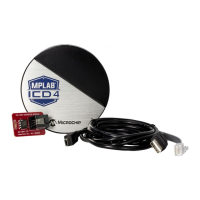MPLAB
®
ICD 4 USER’S GUIDE
DS50002596A-page 63 2017 Microchip Technology Inc.
Appendix B. Hardware Specification
B.1 INTRODUCTION
The hardware and electrical specifications of the MPLAB ICD 4 In-Circuit Debugger
system are detailed in the following sections.
B.2 HIGHLIGHTS
This chapter discusses:
• USB Port/Communication
• MPLAB ICD 4 In-Circuit Debugger
• Standard Communication Hardware
• ICD Test Interface Module
• Target Board Considerations
B.3 USB PORT/COMMUNICATION
The MPLAB ICD 4 In-Circuit Debugger is connected to the host computer via a USB
port, version 2.0 compliant. The USB connector is located on the side of the debugger.
The system is capable of reloading the firmware via the USB interface.
Power for the debugger can be derived from the USB interface, however, the USB
connection is primarily for communications between the computer and the debugger. It
cannot be used to power the target. An external power supply is required. The
debugger is classified as a high-power system per the USB specification, and requires
300 mA of power from the USB to function in all operational modes
(debugger/programmer).
Cable Length – The computer-to-debugger cable, shipped with the debugger kit, is the
correct length for proper operation.
Powered Hubs – If you are going to use a USB hub, make sure it is self-powered. Also,
USB ports on computer keyboards do not have enough power for the debugger to
operate.
Computer Hibernate/Power-Down Modes – Disable the Hibernate or other power
saver modes on your computer to ensure proper USB communication with the
debugger.
Note: The MPLAB ICD 4 In-Circuit Debugger is powered through its USB
connection. The target board is powered from its own supply.

